Author: Danny Casey
We are experiencing what could almost be described as a renaissance period for outboard motors, in terms of technology, model variants and power output – with particularly exciting offerings in the mid-high horsepower segment. From the relative doldrums of a decade ago, when sales flagged and where a jumbled mix of different technologies was offered in a scattergun attempt to comply with international emissions regulations, there is now focus, cohesion and confidence as all manufacturers resolutely commit to a lean, clean, green future. Danny Casey examines the current wave of success and offers some thoughts and opinion into future trends for the industry.
Decades of Development
Over the last five or six decades, it is remarkable to think that we have seen 2-stroke outboards that initially required thick, treacly fuel/oil mixtures of 16:1 (10:1 if one were the proud possessor of a British Seagull!), progressively dropping, as firstly oils then manufacturing processes, tolerances and metallurgy all became progressively better, to 25:1, 33:1, then 50:1. The late 1970s even saw the introduction of a 100:1 fuel/oil mixture by Yamaha and the early 1980s saw no need for oil and fuel premixing at all with the introduction of oil injection on 2-stroke outboards by Suzuki.
We have seen old spluttering, sneezing OMC motors with adjustable high- and low-speed carburettor jetting, then fixed high speed jets, followed by fixed jets for both carburettor circuits. After that, we had rudimentary, analogue, indirect fuel injection on 2-strokes, followed by digital fuel injection, then directly-injected lean-emission 2-strokes. These were followed by a variety of carburetted and fuel-injected 4-strokes. Today, we even have 4-strokes with direct fuel injection. We have gone from puny, unreliable ignition systems using contact breaker points, through to capacitor-discharge types and latterly ultra- powerful, solid-state, fully electronic and computer-controlled ignition systems. Furthermore, one can now buy a light, compact, portable 4-stroke outboard (manual start) with electronic fuel injection which doesn’t even require a battery to power either the ignition or the fuel-delivery system.
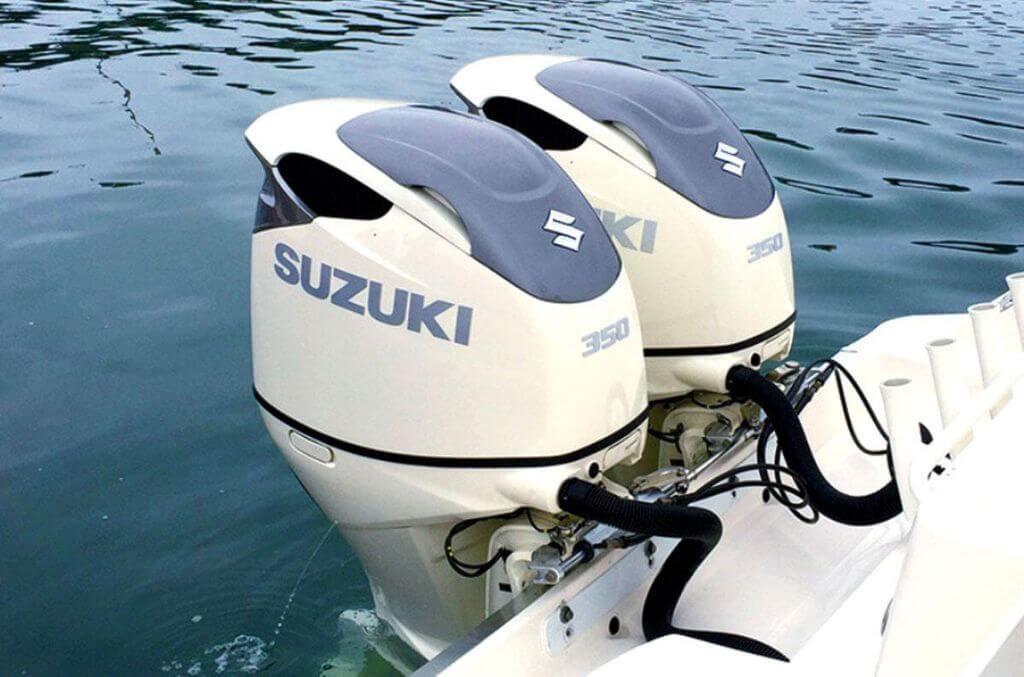
In addition to the above, there are now also options in both the diesel and electric segments, topping off a whole gamut of technology that now closely mirrors the automotive world. It is to be applauded that the marine industry, despite its minuscule size and relatively paltry volumes in comparison with the automotive and power equipment industries, has more than held its own in relation to making the whole end-user experience as clean, conscientious and user-friendly as possible – and at no insignificant cost.
Despite this being written during the bizarre, darkly surreal, soul-destroying days of enforced isolation necessitated by Covid-19 (where all rational economic modelling, forecasts and projections presently count for nothing), it should be noted that, not withstanding, sales of all models of all outboard brands have never been stronger. And this is even with a pronounced and unprecedented worldwide shortage of high-horsepower outboards during 2018 and most of 2019. This shortage, totally due to all manufacturers’ inability to keep up with surging demand (mainly from boat builders who were deserting the sterndrive sector in hordes), held up boat production worldwide, even causing one North American manufacturer to enter Chapter 11 bankruptcy because they were apparently unable to obtain engines for presold boats.
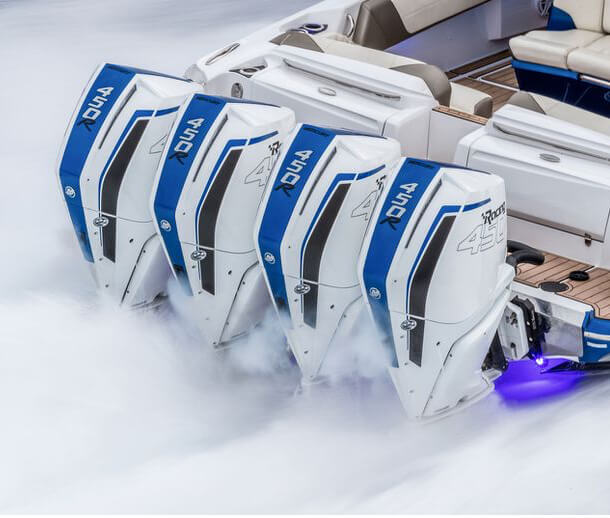
The Macro View
Perhaps the best way to deliver a piece like this so that it is cogent, logical and interesting (and doesn’t insult the reader’s intelligence or bore him/her rigid) is to divide our journey into segments: a glance at the industry overall, then a look at the mainstream petrol segment, followed by the relatively new diesel and electric sectors. We can finish with the usual (and hopefully not-too-hackneyed) “crystal ball”-type pontifications and projections. So, let’s do that, then…
The Industry Internationally
I previously alluded to outboard motor volumes in an earlier piece, and although reluctant to revisit old ground, I believe a recap is needed on the scale and volume of the industry. Global demand for outboard motors in 2019 was close to 850,000 units. Not an overly huge industry, then, as that figure is for all brands, especially when one considers that someone like Mazda – considered a small-midsize automobile manufacturer – produces about 1.5 million vehicles per annum. However, between six mainstream outboard manufacturers, there is theoretically more than enough business for everyone.
In terms of volume, Yamaha is the world leader in the manufacture and sale of outboards, followed by (but no assumptions on market position to be offered or inferred!) Tohatsu, Suzuki and Mercury. The remaining two, very much runners-up in terms of volume, are Honda (surprising, as Honda is the world’s largest manufacturer of engines in general) and BRP. Bear in mind, though, that Tohatsu gains production volume through engines sold on an OEM, rebranding basis to both Honda (their BFT series of 4-stroke outboards 60 hp and above) and BRP (Evinrude 4-strokes up to 15 hp).
Of the 850,00 outboards sold worldwide in 2019, just over 300,000 (over 35%) of those were in North America – and of those 300,000 + outboards, more than 50% were in the 150 hp category and above. The market in Europe in 2019 was for over 260,000 units, although the horsepower trend is the inverse of the US, with over 50% of the market being for engines up to 100 hp. Outboard sales for the “rest of the world” in 2019 were in the region of 275,000, and the combined ANZ total from that rest-of-the-world number was about 45,000 units.
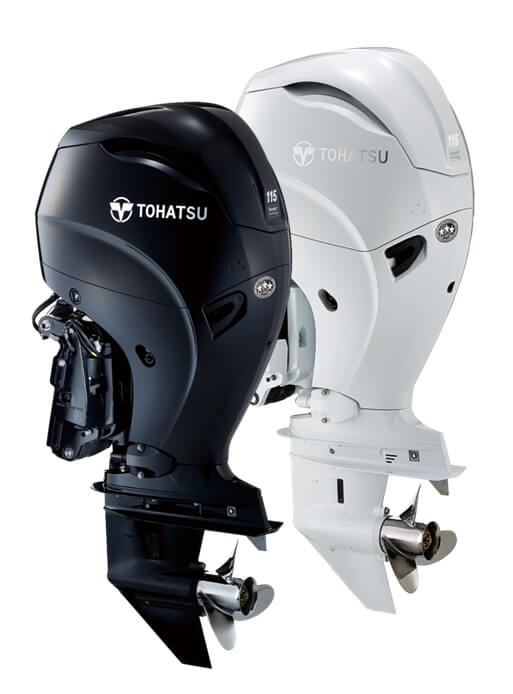
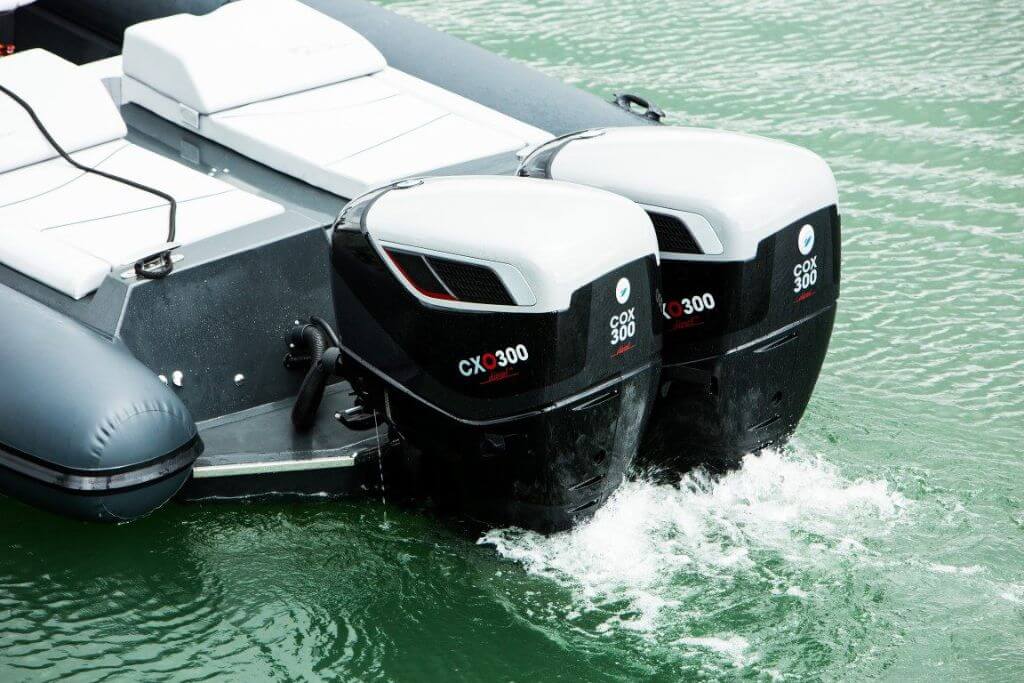
An important point to bear in mind, particularly in relation to the current industry abandonment of gasoline sterndrives, which are at barely 20% of the sales volume of a decade ago (and which will probably never, ever recover), is that outboard companies like Yamaha, Mercury and Suzuki, who are manufacturing higher-horsepower motors than ever before, will almost certainly be able to sell every extra unit they have the capacity to make, as erstwhile sterndrive stalwarts such as Sea Ray, Regal, Campion, Cobalt and Monterey switch resolutely and definitively to outboard power.
Petrol Performing Powerfully
There is little doubt that three of the six major outboard manufacturers (Yamaha, Mercury and Suzuki) are now on top of their respective games in terms of technology, product offerings, excellence and reliability. It is now possible to buy an outboard motor from 2.3 to 450 hp with no gaps in the horsepower segments in between, although three of these brands are relatively weak in higher-horsepower offerings
The three ancillary players are Honda (whose range currently stops with their 3.6 litre 250 hp and is unlikely to grow unless and until Honda produces an automotive block in excess of that capacity which the Marine Division can “borrow”), BRP (which makes only DI 2-strokes and whose range stops at 300 hp), and Tohatsu (although this brand, after having just introduced its own in-house MFS115A 115 hp 4-stroke
motor at Dussdeldorf in January, could prove to be a real revelation). These three brands will almost certainly continue to be supporting players in the current climate. A couple of exceptions to my theory would perhaps be in the European RIB, Cap Camarat-type walkarounds and “peche-promenade” fishing boat segments, and maybe even in the ANZ region with manufacturers of midsize alloy boats, where there is excellent potential for the likes of Honda and Tohatsu to supply engines up to 100-115 hp (categories in which they are relatively strong), as the larger players struggle with demand for high-horsepower units.
As for high-horsepower outboards, I, would have seriously staked my reputation (such as it is!) a decade ago on 350 hp being the absolute usable maximum of where outboard horsepower ratings would go. After all, there must be a threshold, one would think, where a really large boat needs a) the heft of two diesels under the cockpit for low-down weight, balance, good seakeeping, packaging and aesthetics, b) large propellers (in both diameter and pitch) able to really churn and “grab” water then push, lift and carry the hull of the boat in the way the designer intended, c) the ability to have a hot-water supply (for cooking or stay-aboard ablutions) by means of a heat exchanger incorporated on the engine, and d) no risk of a fiery conflagration from hundreds of litres of gasoline stored in the bilges! But I must concede that I seem to have been wrong, as even manufacturers of “Picnic”-type launches and Maine-style “down-easter” boats are now embracing large outboards with a fervour.
To this end, I would be prepared to speculate that the likes of the Yamaha 425 XTO and the Mercury 450 V8 (currently assembled by Mercury Racing but almost inevitably set for mainstream production) could be the opening gambits in the high-horsepower war, with eventual outputs of 500 hp from each of these engines not inconceivable. Mercury has indeed been a revelation with the verve, confidence and rapidity with which it has introduced an entirely new, clean-sheet range of 4-stroke V6s and V8s. But you still won’t be able – due to an outboard’s raw-water cooling system – to draw off water to make a cup of tea or have a shower!
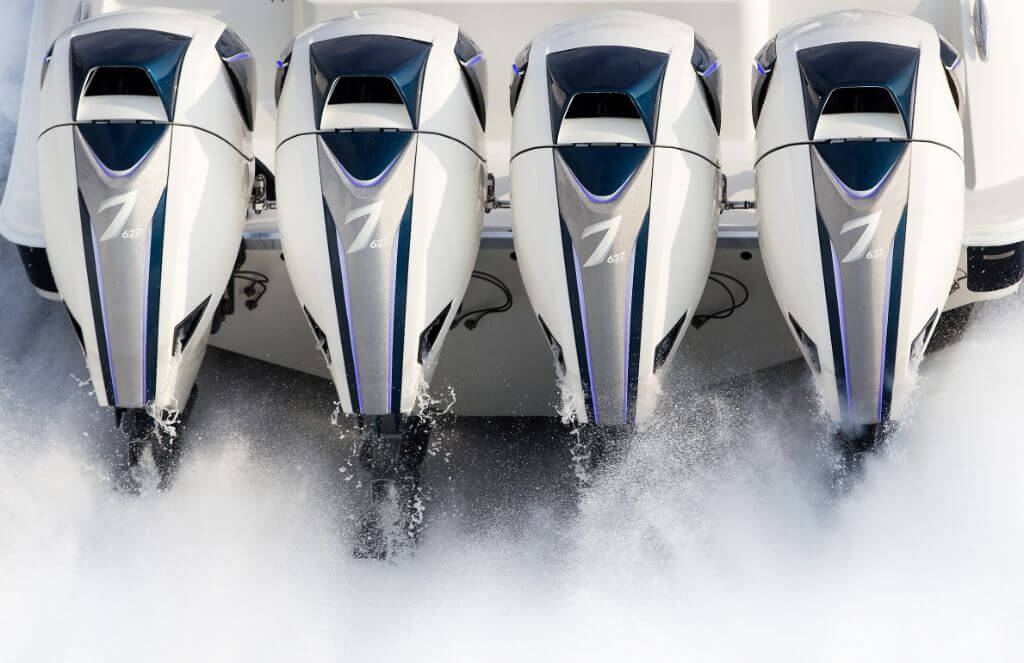
I don’t know that Suzuki will go any larger than their current DF350A, as that engine is in a particular “sweet spot” for high-horsepower outboards, and I’d nearly bet that the combined worldwide numbers for all outboards larger than that (including Seven Marine’s 527-627 hp units) wouldn’t even come close to the total number of all different-brand 350 hp units currently sold. However, Suzuki has shown that it can make – entirely from scratch, and without appropriating automotive blocks – what it needs to make, and with the building of a new testing and development centre in Panama City, Florida, the company is obviously deadly serious about partnering with many boat brands with whom they may previously had had fleeting or nascent relationships.
I have written on at least a couple of occasions that, in terms of the outboard industry, Honda has always, sadly, managed to “snatch defeat from the jaws of victory”, and I currently see no reason to amend this view. The engines produced by this company – the original forerunner in 4-strokes, don’t forget – are worthy, smooth, superbly engineered and magnificently presented. But their larger offerings are slow, heavy, bulky and do not perform as well as their competitors. Also, they have yet to adopt the use of electronic fuel injection in their compact-midrange (15-30 hp), which everyone else now does. This is strange, as Honda has doubtlessly been making battery-less fuel injection systems for years for motocross bikes. I expressed an opinion before – but an opinion is all it is – that it would not be surprising to see Honda’s outboard product line eventually becoming the property of Tohatsu (to whom Honda currently supplies OEM product). Honda’s previous passionate ethos of creating cars with free-revving, naturally-aspirated engines has been supplanted by their current policy of now building rather frenzied, frenetic,
small-displacement engines requiring turbocharging to achieve power – totally unsuitable for donor power units for marine engines. Add to this Honda’s new-found fervour for the aviation industry with the creation of their business jet, and one can surmise that the outboard segment is an adjunct or distraction at best. A real shame, this, because Honda was so successful in the 4-stroke outboard segment in the late 1990s (in fact, the start-up and tooling costs on the first BF75/90 were amortised in less than one year) that they could have led decisively while the others struggled to even devise a response.
Tohatsu, the oldest Japanese outboard manufacturer, is undoubtedly “the little engine that could”, and I cannot see how their trajectory will be anything but solidly upward. They have a superb small-horsepower range (most of which is also sold by both Evinrude and Mercury), and two magnificent, lightweight midsize models in the MFS50A and MFS60A. Their lightweight new MFS115A prototype, shown at Dusseldorf, and from which there will be 75/90/100 hp derivatives, will pad out their range and, leaving aside the Honda-supplied engines, I wouldn’t bet against Tohatsu being able to develop and manufacture an in-house high-horsepower outboard.
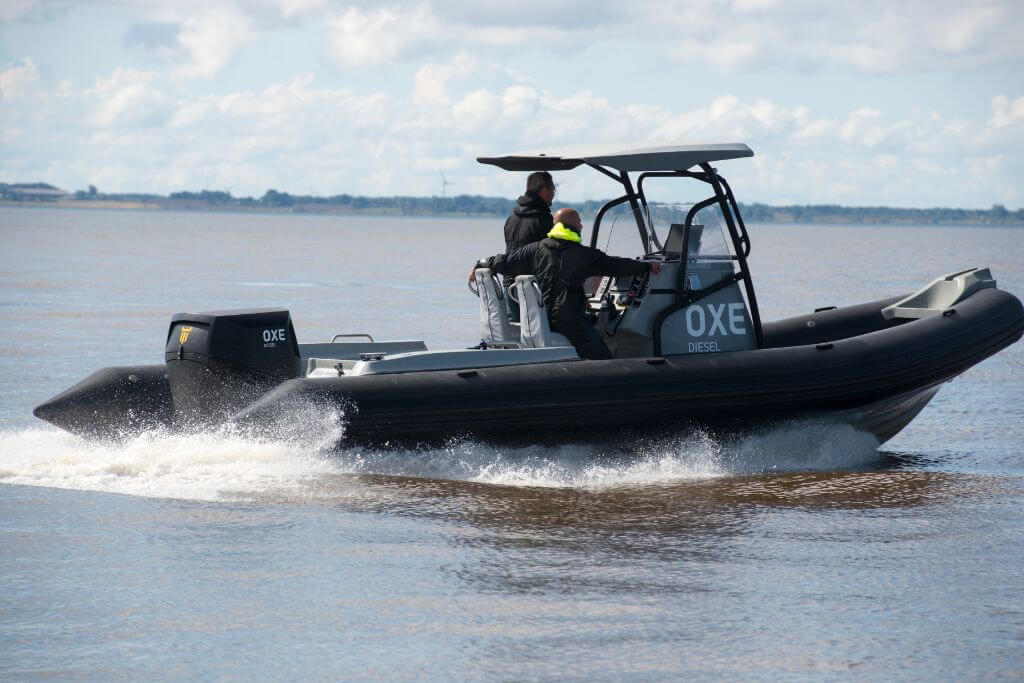
The only remaining “name” manufacturer is BRP’s Evinrude, and although their E-Tec product is sophisticated, technologically advanced, innovative and strikingly presented, I truly cannot see the brand gaining much, if any, market share. Being 2-strokes, albeit of the very clean direct-injection type, the motors still use oil in what is known as the “total loss” principle (i.e. all oil in the reservoir is used and discharged through the exhaust, so a fill-up is required). While it is true that, due to the nature, intensity and completeness of the DI combustion process, the emission of harmful NOx (Nitrogen Oxide) gases is in fact lower than on competitors’ 4-strokes, that fact wouldn’t be enough to make me invest in an E-Tec, I’m afraid.
However, BRP has placed the evocative and much-revered “Johnson” name on somewhat of a sabbatical for several years, and I really believe that if they want to remain relative and viable in the outboard industry, they should dust off the Johnson name for an all-new range of Rotax-based 4-strokes.
To round off an overview of petrol outboards, we need only mention in passing Selva of Italy (most of whose 4-strokes are rebranded Yamahas anyway and unavailable in this region), Parsun and the other Chinese brands (most of which are blatant, slavish, unashamed copies of Yamaha’s back catalogue), and the quirky, expensive, bespoke and powerful outboards from 7 Marine, now part of Volvo Penta and assembled at Volvo Penta’s plant in Lexington, Tennessee.
It is worth highlighting the 7 Marine outboards, which come in 527, 577 and 627 hp variants and are the result of using a closed-loop, water-cooled GM LSA V8 engine of 6.2 litres mounted horizontally (unlike the vertical orientation on a conventional outboard) on a bed plate. The engine drives through a complex ZF Marine wet disc transmission to a large, sterndrive-sized lower unit available in either single or dual-propeller configuration. Be mindful that we are talking here about an outboard motor with a price tag well into six figures, so any impact on the boating arena in this region will be minimal. Furthermore, I cannot see why Volvo Penta would buy a controlling interest in this enterprise, which presently depends on the purchase of expensive, fully-assembled high-output engines from GM (on which the original cylinder heads and camshafts are then changed at the 7 Marine factory), if they didn’t have plans to develop the concept and increase the product line. The marinization of the bought-in GM engine, and the relatively small number of potential sales, must mean that, at current production volumes, amortisation and recouping of set-up and production costs will be well into the future. Surely it would not be a stretch of the imagination to believe that, in its own time, Volvo will almost certainly start producing large diesel outboards – for which they can use their own engines. This is pure speculation, but there may possibly be something – whether it be a licensing, copyright or patent issue – that is preventing Volvo Penta from producing high-horsepower diesel outboards in this Tennessee plant at present. But whatever issues exist, they will not exist forever.
Dabbling with Diesel
Logically and ideally, there is no better fuel for a marine engine than diesel, in terms of a) energy produced, b) engine thermal efficiency (over 40% compared with 30% in a 4-stroke petrol engine and under 10% in an old carburetted 2-stroke, c) economy, d) availability in remote locations and e) low fire risk. Also, if one needs an engine to work hard for many hours, the compression-ignition characteristics, relatively low engine speeds (although the RPM levels of modern diesels are starting to creep up into old-time petrol territory) and low-down torque are all huge diesel pluses.
There have been some unbreakable, epoch-making inboard marine diesels over the decades, but the concept had never filtered down successfully into the area of outboards unless one counts the magnificent Yanmar D27/36/40 hp 3-cylinder diesels – no longer available new but still hugely sought after, with associated premium pricing, in developing nations not yet saddled with strict emissions regulations. A couple of Ruggerini outboards – 15 and 25 hp (on Selva centre sections) – were available some years ago in Europe, but refinement was neither a priority nor a feature.
So why has no one – especially one of the major outboard manufacturers – offered such a unique, fit-for-purpose product with a guaranteed customer base? I’m guessing the reasons would be cost of tooling, low volumes and protracted return on investment.
In relation to timely and potentially viable diesel outboards, however, there have been three, maybe four (if one includes a somewhat left-of-field curio which we shall examine later), new products that have piqued the interest.
The first example is the Neander DTorque 111 (“111” is the torque developed in Nm), manufactured by Neander GmbH in Kiel, Germany but distributed globally by Yanmar Marine as a de facto Yanmar product. The 50 hp Neander unit looks relatively mainstream and in fact the graphics, at a distance, are redolent of the later Mariner outboards! The power unit is mounted on a centre section and lower unit supplied by Selva in Italy (who also does the castings for Yanmar’s ZT370 sterndrive and sail-drive). The common-rail power unit incorporates a complex but effective, and excellently balanced, system of twin counter-rotating crankshafts. At 175 kg, the 50 hp DTorque is far from light but if, as has been mooted, the manufacturers are eventually able to raise the output to 70 hp without increasing either size or weight, then new market opportunities are assured.
At present, the DTorque seems to be tentatively yet creatively pitched in the lucrative superyacht tender market, where there is a desire for commonality of fuel on board with no need to have designated storage for gasoline, which is obviously much more flammable (although many superyachts also carry personal watercraft, but nobody yet makes a diesel-powered PWC!). As an aside, however, in any brochure and magazine tests I have seen, the motor has always been on small, light RIBs, sitting far too low in the water at rest with the static water level up to the bottom of the lower pan – not a good look! While this engine does have immense potential, particularly if or when they increase the output without adding weight, it is very expensive – currently about $1,000 per horsepower in Australia – and will, for the foreseeable future, be limited to commercial users and the rich.
Another relative diesel newcomer is the Swedish-built OXE, available in 125-300 hp outputs – derivatives up to 200 hp use an Opel (now PSA) 2-litre engine, but the forthcoming new flagship 300 hp variant will have a BMW power unit. Like Volvo-Penta’s 7 Marine outboard, the OXE also has an automotive-sourced power unit mounted horizontally on a bed plate, with (like the 7 Marine engine) a closed-loop cooling system and with the transmission (on which the gear ratios can be changed) mounted under the power unit on the back of the leg. The fully-shifting transmission then transfers the power to the lower unit (a drive unit only, not a gearbox) by means of a wide, heavy-duty ceramic belt (like one would see driving a supercharger etc.).
The concept of a belt-driven propeller shaft is, in theory, quite good, as it does away with the usual cluster of meshed, spiral-bevel gears in a conventional outboard lower unit. With the massive low-down, “churning” torque of a diesel, a gear set is always the potential Achilles heel, as too much time operating at peak power can cause catastrophic failure – just ask anyone who ever coupled a diesel to a sterndrive unit originally designed for a petrol engine!
I can’t think of any leisure user, except a rich one, who would currently buy an OXE but, high price notwithstanding, it is a suitable solution for commercial operators, water taxi operators, military and police. At 350 kg for the 4-cylinder models, it’s certainly not light (a borderline power-to-weight ratio for a 200 hp but poor for the 125 hp variant) but, on the types of heavy commercial boat to which it will be fitted, the weight issue would not be insurmountable.
Yet another new diesel outboard whose arrival is keenly awaited is the CXO 300, a 300 hp unit by Cox Powertrain in the UK. This engine has had a long and intensive gestation period – over a decade, in fact – and its introduction had been deferred because the manufacturer wanted all potential bugs ironed out before full production commenced. Despite having a diesel power unit, Cox’s CXO 300 avails of some established outboard thinking in that it utilises raw-water cooling (i.e. cooled by the water in which the engine is being operated) and a conventional, gear-shifting lower unit with spiral/bevel gears. The power unit, a 4.4 litre V8 with a 60-degree angle (not an ideal angle for eradicating second-order vibration in a V8 – just ask Yamaha about the F350A!) is reputedly a proprietary, clean-sheet design. However, I happened to see someone, on some obscure forum or other, noting that the bore and stroke were the same as in the Land Rover/Range Rover V8 and asking if this meant that JLR supplied the block. Who knows? But even if it were a Land Rover diesel engine, that would be no bad thing.
This unit is listed as weighing in at a heavy(ish) 380 kg for the 25” XL shaft version, but again, and as per the OXE, the weight will not be a huge factor on the types of boats to which the engine will be fitted. Interestingly, there is a choice of two gear ratios from the factory and the engine will also be available with a 35” shaft (which is another size up from the current industry-standard 30” UL). This is an excellent idea, as it will keep the power unit well up out of the water and allow for higher aft freeboard on the boat. If the lower unit can cope with the torque and effectively convert it to thrust, this engine should find its way onto many police, patrol and rescue boats – but pricing will certainly restrict it to those segments.
To round off our diesel review, the left-of-field curio to which I alluded earlier is from Hyundai SeaSall and could, I suppose, be loosely classed as an “outboard” of sorts. It is called the S30-OB and is an external, transom-mounted, pod-enclosed power unit built around the durable, ultra-reliable 3.0 litre V6 diesel that has been on the market for well over a decade in marine form (for sterndrive, shaft or jet applications) in an output of 270 PS.
This is a reasonably good concept, albeit not particularly appealing in terms of aesthetics and packaging. It is a fully self-contained power unit in a box (or pod) that is both ventilated and water-resistant. The engine sits atop a V-drive transmission which attaches to an outboard-type through-hub propeller by means of a propeller shaft. What appears to be a facsimile of a conventional outboard case is attached to the bottom of the pod, but the lower unit is fixed in the straight-ahead position and steering is by rudder. The rudder is conventionally secured to the bottom of the pod by means of a pintle above and a horizontal bracket below.
The S30-OB has an integrated hydraulic steering system and, in a nod to its targeted commercial market, also incorporates hydraulics to run winches and pot haulers etc. As such, there is, I feel, a definite niche for this unusual “outboard” – well, outboard propulsion unit, anyway. Drawbacks are its weight of 625 kg (a lot to be hanging off a transom with the “pendulum” weight of the power unit much farther back than with a normal outboard) and the fact that it mounts on the transom with plates and braces which do not in any way resemble the standard industry mounting-bolt pattern.
Not a bad effort from Hyundai, though, but one feels that they should have milked their existing relationship with Mercury (whose sterndrives they already use) and bought in an outboard centre section and lower unit on which they could have mounted the engine. Or better still, Hyundai could have designed a whole “pure” outboard concept from scratch – after all, it is the one Korean company ably equipped with the nous, technology and capability to so do.
The Energy of Electric
The subject of electric outboards had, until recently, been virgin and, quite honestly, contemptuously disregarded territory by me. I didn’t, and still don’t, have much interest in “motors” that make a sterile, anodyne whirr over “engines” that make evocative, exploding combustion noises. But it’s an ignorant man that won’t move with the times, and this was starkly brought home to me some weeks ago when a power product dealer informed me that his supplier (a household name in that sector) estimated that, within four years, over 75% of the garden equipment they supply will have migrated to battery power. To say I was stunned would be an understatement.
A key factor in the current fervour surrounding battery-powered machinery of all types is the gargantuan improvement in battery technology in the last decade. Lithium-ion cells are the reason, and compared with the old-style (and still very popular) Absorbent Glass Mat (AGM) batteries, a lithium-ion battery will hold a high, constant, unvarying level of power for much longer. Anybody who has ever operated even a simple flashlight or an older battery drill will know that the power or potency of the battery starts to drop right away and, with each period of use, the bulb will progressively dim or the drill will rotate noticeably slower. But with a lithium-ion battery, there will be no pronounced drop-off in performance until the battery charge has depleted by 85%. It is therefore logical that a battery of this type would be eminently suitable for supplying tractive or motive power.
A company one would never have associated with the virtually-silent world of electric marine propulsion is the long-standing, respected German diesel engine company, Deutz. Anyone who has used construction machinery or industrial equipment will possibly have experienced the power, durability and reliability of a Deutz engine – many of which were (and still are) air cooled. But Deutz (like its compatriot, Volkswagen) sees immense potential in electrification, and their purchase, last year, of Torqeedo in Friedrichshafen confirms this.
Leaving aside the might and foresight of Deutz, the advent and greater availability of lithium-ion batteries almost certainly means there will be massive growth in the number of like-minded companies creating electric versions of internal combustion-powered products. Were I a manufacture of petrol-powered outboards, I wouldn’t – yet – be overly worried about the current rush towards electrification, but there is little doubt that the likes of the Torqeedo motors will eventually start to capture sales in the light portable (2-15 hp) outboard segment. Just think about this (even though it pains me greatly to say it!): if I were the owner or buyer of a large, expensive boat for which I needed a tender, and if I needed an outboard to run only from the beach or jetty to the boat, then electric would be a logical, intelligent and conscientious choice. Not to mention quiet and light. The limited need for an outboard by the owner means there is no need to store petrol aboard the mother vessel in a lazarette or locker, and there is no need to worry about how to stow a small 4-stroke safely without oil entering the cylinder (although, to be honest, all small 4-strokes can now be lain down in any of three different positions – front, right- and left-hand side). I believe – predict, actually – that once Torqeedo starts encountering competitors and the price of battery outboards subsequently undergoes a downward correction, then every single one of the major gasoline outboard manufacturers will eventually see an inexorable encroachment into their portable segment.
There can be little doubt that Torqeedo will indeed soon have competition, possibly from worthy entities like Minn Kota, MotorGuide and even Garmin – all experienced in the manufacture of trolling motors, so how hard would it be for them to adapt to producing relatively simple transom-mount motors?
Let’s face it… if an owner spends as long priming the fuel bulb, flicking on the choke, fastening the kill cord and pulling the starter cord as the time taken for the actual trip between the shore and a moored boat, then why would he pick an internal combustion outboard? Likewise, if one has the money to buy a new flybridge cruiser, a launch or a trawler yacht while still wishing to espouse and propagate an environmental conscience, then a portable electric outboard for the tender makes a statement.
I do believe, however, that unless battery technology advances even more rapidly and innovatively, the future for larger portable, midsize and high-horsepower gasoline outboards is secure for years to come. Granted there have been several experiments in Europe, particularly by a Norwegian company called Evoy, which is experimenting with an E-TEC engine exterior casing (presumably with an electric motor installed instead of the original gasoline power unit) coupled to a bank of batteries in a specially-adapted Zodiac Milpro boat, and this unit has been rated at the equivalent of 150 hp. Innovative stuff to be sure, but one wonders what boat builder currently has the time, inclination or resources to design a vessel around a huge bank of batteries. Plus, would the boat float properly? How would it handle? How would its buoyancy be affected? Would it be deader, and lower, in the water?
But rest assured of one thing: we can resist all we want (like the way the blacksmiths held out when the horseless carriage arrived or the way we’ve all futilely tried to resist Skype and Zoom meetings), but it certainly won’t only be my mate the power product retailer who will soon be selling mostly electrically- powered machinery. The ICE (internal combustion engine) may be far from dead, but it has a silent, stalking, lurking adversary.
The Wrap-Up
Despite the seeping but inexorable encroachment of diesel and battery technology, the petrol outboard as we now know it will be around for decades to come. Let’s face it: petrol is still, per litre, one of the cheapest substances sold today – and if anyone can tell me that a modern fuel-injected 4-stroke is not a gargantuan and cathartic improvement over the old smoke-belching old 2-strokes we were still using at the start of this century (and which some of us are still using today!), then I’d have to ask that person what he or she was smoking.
One thing I didn’t touch on in the main text – and the reality of it is now starting to bite – is the banning of the sale of all conventional 2-stroke outboards in Australia (and, by default, New Zealand as well, as many of the importers are the same entities) from this July. For many on a budget, purchasing a new 4-stroke is out of the question, and I predict a healthy satellite or sub-industry for the reconditioning and retail of late-model 2-strokes. In fact, one dealer on Sydney’s Northern Beaches told me that he had a huge level of enquiry from commuters (those who live on the nearby islands and who only use a dinghy to catch the bus on the mainland) for good, clean 15 and 25 hp 2-stroke motors. So, as a sub-species and now somewhat estranged member of the gasoline outboard family, the 2-stroke may, paradoxically, undergo something of a brief renaissance too.
I’d have to say, though, that in all the years (decades, actually) that I have been involved with marine engines and outboards especially, the current technology trends are positive and indicative of some innovative, far-sighted vision and creativity. Power outputs will continue to rise; noise levels and fuel consumption will continue to fall; operational convenience and driveability will improve, and the choice of types, variants and fuel will become greater. There’s some good news for everyone there, I’d say.




